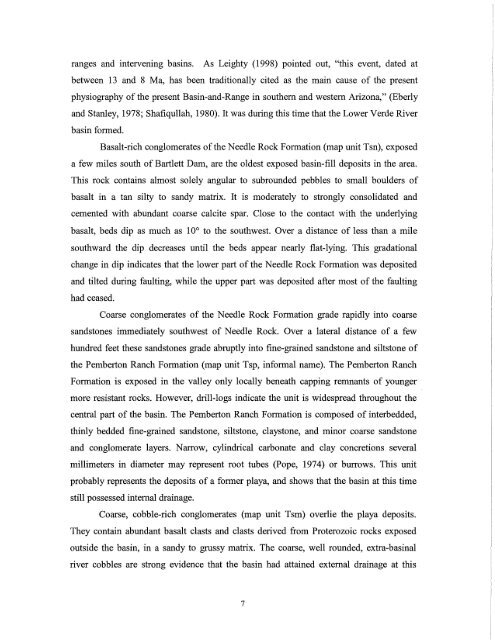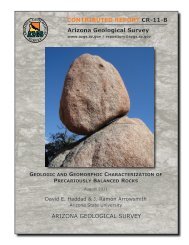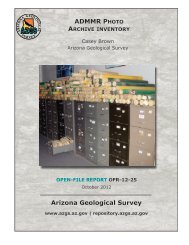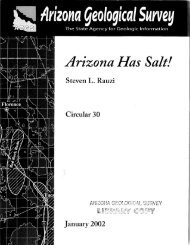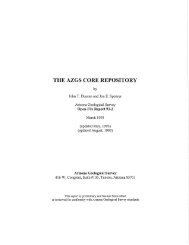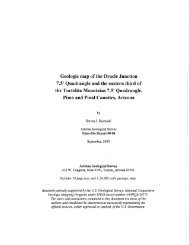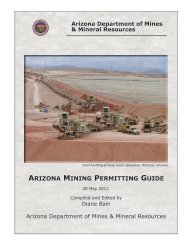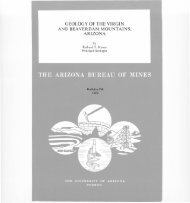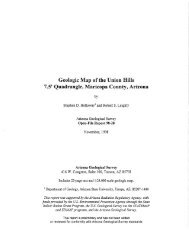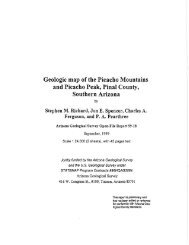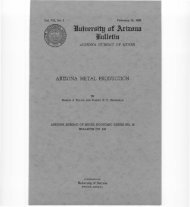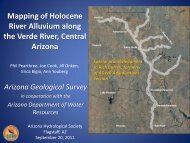Subsurface Geologic Investigation of Fountain Hills - AZGS ...
Subsurface Geologic Investigation of Fountain Hills - AZGS ...
Subsurface Geologic Investigation of Fountain Hills - AZGS ...
Create successful ePaper yourself
Turn your PDF publications into a flip-book with our unique Google optimized e-Paper software.
anges and intervening basins. As Leighty (1998) pointed out, "this event, dated at<br />
between 13 and 8 Ma, has been traditionally cited as the main cause <strong>of</strong> the present<br />
physiography <strong>of</strong> the present Basin-and-Range in southern and western Arizona," (Eberly<br />
and Stanley, 1978; Shafiqullah, 1980). It was during this time that the Lower Verde River<br />
basin formed.<br />
Basalt-rich conglomerates <strong>of</strong>the Needle Rock Formation (map unit Tsn), exposed<br />
a few miles south <strong>of</strong> Bartlett Dam, are the oldest exposed basin-fill deposits in the area.<br />
This rock contains almost solely angular to subrounded pebbles to small boulders <strong>of</strong><br />
basalt in a tan silty to sandy matrix. It is moderately to strongly consolidated and<br />
cemented with abundant coarse calcite spar. Close to the contact with the underlying<br />
basalt, beds dip as much as 10° to the southwest. Over a distance <strong>of</strong> less than a mile<br />
southward the dip decreases until the beds appear nearly flat-lying. This gradational<br />
change in dip indicates that the lower part <strong>of</strong> the Needle Rock Formation was deposited<br />
and tilted during faulting, while the upper part was deposited after most <strong>of</strong> the faulting<br />
had ceased.<br />
Coarse conglomerates <strong>of</strong> the Needle Rock Formation grade rapidly into coarse<br />
sandstones immediately southwest <strong>of</strong> Needle Rock. Over a lateral distance <strong>of</strong> a few<br />
hundred feet these sandstones grade abruptly into fine-grained sandstone and siltstone <strong>of</strong><br />
the Pemberton Ranch Formation (map unit Tsp, informal name). The Pemberton Ranch<br />
Formation is exposed in the valley only locally beneath capping remnants <strong>of</strong> younger<br />
more resistant rocks. However, drill-logs indicate the unit is widespread throughout the<br />
central part <strong>of</strong> the basin. The Pemberton Ranch Formation is composed <strong>of</strong> interbedded,<br />
thinly bedded fine-grained sandstone, siltstone, claystone, and minor coarse sandstone<br />
and conglomerate layers. Narrow, cylindrical carbonate and clay concretions several<br />
millimeters in diameter may represent root tubes (Pope, 1974) or burrows. This unit<br />
probably represents the deposits <strong>of</strong> a former playa, and shows that the basin at this time<br />
still possessed internal drainage.<br />
Coarse, cobble-rich conglomerates (map unit Tsm) overlie the playa deposits.<br />
They contain abundant basalt clasts and clasts derived from Proterozoic rocks exposed<br />
outside the basin, in a sandy to grussy matrix. The coarse, well rounded, extra-basinal<br />
river cobbles are strong evidence that the basin had attained external drainage at this<br />
7


